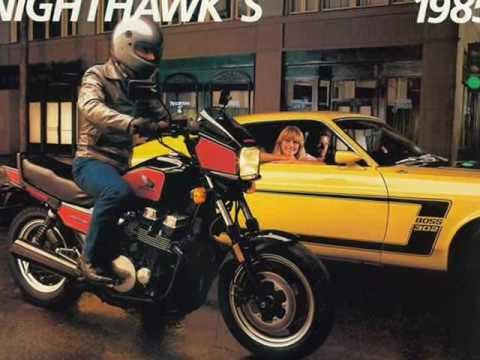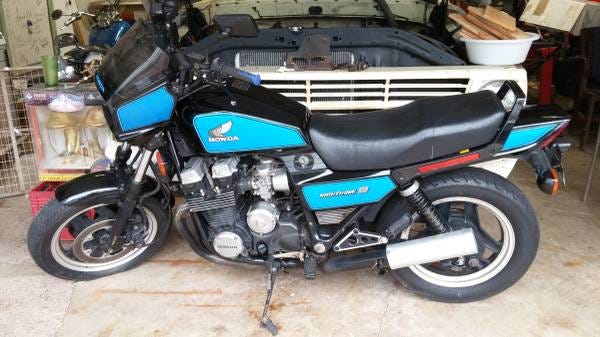For $1500, I Can Re-Create This Brochure Cover; Also, A Brief Economic Discussion

I certainly don't need another motorcycle, and I certainly can't afford another motorcycle, and I shouldn't let the fact that I have a motorcycle on loan to my ex-wife's husband (there should be a shorter way to say that --- maybe "successorhub" or something) let me think that there's an open space in the garage.
Nevertheless. There is a Nighthawk "S" for sale in Columbus. As a kid, I thought it was one of the coolest motorcycles ever. It wasn't a racer-replica --- it was just a cool thing. And, as it turns out, we have Harley-Davidson to thank for its existence, and the United States Government to thank for the existence of Harley-Davidson.
Can any of you identify this track? I'm pretty sure its Willow Springs. I recognize the corner station that appears on the left about halfway through the ad. Might be "Streets Of Willow". Even with a pro rider on it, the Nighthawk 700SC isn't exactly capable of a Marc Marquez shoulder grind. Not to worry; it was a shaft-drive street cruiser, meant to hustle between stoplights and absolutely capable of doing so. It had a big-bore, short-stroke variant of the Nighthawk 650 engine and managed a 12.35@107.46mph quarter-mile for the magazines. For comparison, Car and Driver managed 13.3@107 in a privately owned 1986 Testarossa the year after the Nighthawk "S" was introduced.
But why wasn't it a 750? The answer was simple. Harley-Davidson, America's last motorcycle company, was in the middle of being rescued from AMF's disastrous mismanagement. It was taken private by a consortium of nine investors including a member of the Davidson family. Stuck with an antiquated, unreliable lineup and facing dealers who were furious over being saddled with too much unsellable inventory, H-D looked likely to fail in the face of fierce competition from the Japanese manufacturers.
President Reagan signed a massive tariff in April of 1983, increasing import duty for bikes over 700cc from 4.9% to 49%. In 1987, at the request of a revitalized Harley-Davidson eager to earn goodwill with the American public, Harley asked the government to end the tariff. The rest is history; although it was hit as hard as everyone else by the 2008/2009 crisis, Harley-Davidson is in good shape today and easily sells all the $40,000 touring bikes it can build to an increasingly wealthy (and grey) clientele.
In the years of the tariff, the Japanese Big Four (Honda, Yamaha, Kawasaki, Suzuki) showed their agility and competitiveness by immediately dropping their 750cc bikes to 700cc. There were VFR700s and FZR700s and so on. And a few people continued to pay whatever it took to get behind the handlebars of a Japanese literbike. The Gold Wing was already US-made at that point and it wasn't affected by the tariff; in fact, you can argue that Honda's utter dominance of the touring market was assisted by having the only genuinely reliable tourer for sale at a reasonable price in that era. Kawasaki had a USA facility as well but its American-made six-cylinder Z1300 wasn't as well-regarded as the Wing. Economists, both amateur and professional, will tell you that tariffs harm the country that enacts them. And that's true, from a strict maximization-of-utility standpoint. Certainly the overall transaction price for motorcycles went up during the tariff years. But it preserved jobs that would have otherwise been lost. The American motorcycle industry could have simply disappeared for all time, the way the British auto industry did. I would suggest that our country benefited more overall from the retention of Harley-Davidson than it suffered from increased motorcycle transaction prices.
There was another factor at work. The yen, as long-time readers of this blog already know, was undervalued at the beginning of the Eighties. As it rose to a price that more properly reflected Japan's economic power, prices of Japanese goods rose as well. Think of it as a reverse tariff --- simply by pricing your items in yen and building them in Japan, you could make 40% more money or price your products 40% cheaper. What the 49% tariff did was equalize that, and once the yen had risen to an appropriate point, it was no longer necessary to adjust it with a tariff.
Most of you already know I'm going to talk about China now. For years, that monolithically-managed entity has manipulated its currency in such a fashion as to effectively wage war on the United States. Yes, you Econ 101 graduates, the United States has benefited in the short term from cheaper products and services. But in the long term, what's happening is that China is building an Arsenal of Capitalist Psuedo-Communism with the proceeds of this war, the same way the United States used WWII to become the biggest manufacturing power in the world. The Chinese don't think in terms of economics, which is why their markets are wacky and investing there is a game of roulette. They think in terms of jobs, in terms of capacity, in terms of power.
So they're playing chess while we play Tic-Tac-Toe.
Back to the Nighthawk. It was available as a Nighthawk 750S in Canada but nobody seems to have ridden the two bikes back to back so there's no way to know whether the extra 50cc made a difference. The point on which everybody seems to agree: they were brilliant motorcycles. Here's the $1500, two-owner example on my local Craiglist:

I like the idea of buying it, stripping it down to the last nut and bolt, and refinishing/rebuilding the whole thing with all the spare time I do not have and will never have. Or I could just scrub it up a bit and ride it as is. What I would most like to do is get together with my brother and his School Bus Yellow Boss 302 to take a photo in tribute to the original catalog cover. Isn't it interesting, by the way, that the brochure for a 1985 motorcycle features a 1970 car as an example of what's cool? But that's a discussion for another time.

